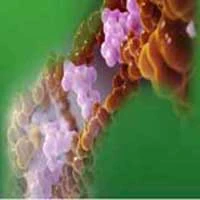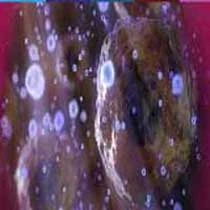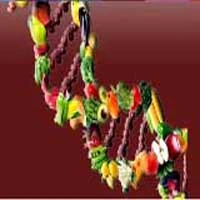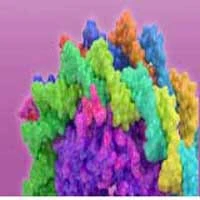Introduction
Novel coronavirus pneumonia [coronavirus disease
2019 (COVID-19)] has rapidly spread in various countries worldwide
since its emergence in December 2019 and has now become a major
global public health problem (1).
The novel coronavirus [severe acute respiratory syndrome
coronavirus 2 (SARS-CoV-2)] has evolved to produce variant strains
with variable transmissibility and virulence, such as Alpha
(B.1.1.7), Beta (B.1.351), Gamma (P.1), Delta (B.1.617.2) and
Omicron (B.1.1.529) (WHO. Tracking SARS-CoV-2 Variants (EB/OL)
2021-12-06 (available from https://www.who.int/) (2). The Delta variant was first detected
in India in October 2020(3). It
quickly replaced the Gamma variant in several countries and regions
worldwide and was designated as a variant of concern (VOC) by the
World Health Organization (WHO) on May 11, 2021(4). The P681R mutation in the Delta mutant
spike (S) protein is one of the key mutations that enhances the
ability of SARS-CoV-2 to fuse with host cells (5). The Omicron mutant strain was first
detected in South Africa and reported to the WHO on November 24,
2021(6). Mutations in more S
protein sites in the Omicron mutant strain further enhanced its
pathogenicity, infectivity and immune escape ability. The mutant
strain was designated as a VOC by the WHO on November 26, 2021
(WHO. Tracking SARS-CoV-2 Variants (EB/OL) 2021-12-06 (available
from https://www.who.int/). Due to its enhanced immune
escape ability and transmissibility, Omicron has replaced other
mutant strains and has become a major epidemic strain in several
countries and regions worldwide (7). Omicron induces an asymptomatic or
mild infection and is highly transmissible, posing a serious
challenge to the prevention and control of the epidemic. In the
present study, the demographic data, clinical characteristics and
negative conversion time of nucleic acids of the new coronavirus in
patients infected with the SARS-CoV-2 wild strain, Delta strain and
Omicron strain in Fujian Province, China, were reported for the
first time, thus providing a reference for the clinical management
of patients infected with new coronary pneumonia in this
region.
Materials and methods
Source of cases
A total of 47 patients with SARS-CoV-2 wild type
strain infection between January 21, 2020 and March 6, 2020,
together with 18 patients with Delta strain infection between
September 12, 2021 and September 15, 2021 and 20 patients with
Omicron strain infection between February 10, 2022 and February 12,
2022, were treated at the Special Ward for Infection Disease, The
First Hospital of Quanzhou affiliated with Fujian Medical
University.
Inclusion criteria
Patients infected with the SARS-CoV-2 wild type,
Delta and Omicron mutant strains were included in this study.
SARS-CoV-2 sequencing was conducted at the Center for Disease
Prevention and Control of Quanzhou.
Exclusion criteria
Patients with incomplete medical data and suspected
cases were excluded.
Diagnostic criteria
According to the New Coronavirus Pneumonia Treatment
Protocol (Trial Version 8) issued by the General Office of the
National Health Commission and the Office of the National
Administration of Traditional Chinese Medicine (8), those with an epidemiological history,
clinical manifestations and positive results on pathogenic or
serological tests are considered confirmed cases of new coronavirus
pneumonia. According to the results of the comprehensive evaluation
of clinical manifestations and auxiliary examinations, these cases
can be classified into mild, common, severe and critical types. In
the present study, an asymptomatic infection carrier was defined as
an individual with a positive nucleic acid test result for novel
coronavirus but without any associated clinical manifestations.
Discharge criteria
Patients i) whose body temperature returned to
normal after more than three days, ii) who demonstrated significant
improvement in respiratory symptoms, iii) whose acute exudative
lesions identified on lung imaging improved significantly and iv)
who showed negative results for two consecutive nucleic acid tests
using respiratory specimens (≥24 h apart) were discharged from the
hospital.
Data collection
The following data were collected: i) Demographic
characteristics (sex, age, underlying disease, COVID-19 vaccination
status and epidemiological history); ii) clinical typing and
clinical symptoms of COVID-19; iii) ancillary tests performed
within 48 h after admission [routine blood tests (Coulter LH750
analyzer; Beckman Coulter, Inc.), complete biochemical tests
(AU5811; Beckman Coulter, Inc.), humoral immunity (IMMAGE800;
Beckman Coulter, Inc.), coagulation screening (ACL-TOP 700; Diamond
Diagnostics Inc.), lung computed tomography (CT; SOMATOM Emotion
16; Siemens AG), blood gas analysis (ABL9; Radiometer Medical) and
analysis of nucleic acid-negative conversion time for COVID-19
(QuantStudio5; Thermo Fisher Scientific, Inc.)]; and iv) efficacy
evaluation (nucleic acid-negative conversion time). The database
strictly regulated the use of the data to ensure security and
confidentiality.
Statistical analysis
Data analysis was performed using IBM SPSS
Statistics for Windows version 23.0 (IBM Corp.). The Kruskal-Wallis
rank sum test or Mann-Whitney U test was used to analyze
non-normally distributed continuous variables (data are presented
as medians with 25 and 75th percentiles). Qualitative data were
analyzed using Fisher's exact test and are presented as
percentages. P<0.05 was considered to indicate a statistically
significant difference.
Results
Study sample and typing
A total of 85 patients were enrolled in the present
study. In the SARS-CoV-2 wild type strain group, four patients had
mild infection, 40 had common infection and three had severe
infection. In the Delta strain group, two patients had mild
infection and 16 had a common infection. In the Omicron strain
group, six patients had asymptomatic infection, seven had mild
infection and seven had common infection.
Demographic and clinical
characteristics
In the present study, no significant differences
were observed in the age, sex and body mass index among the wild
type, Delta and Omicron strain groups. The nucleic acid-negative
conversion time was significantly longer in the Omicron strain
group than in the wild type (Z=16.301, P=0.037) or Delta strain
groups (Z=30.904, P<0.001). The most common clinical
manifestations in the wild type and Delta strain groups were fever
and malaise, respectively. By contrast, the most common clinical
presentation in the Omicron strain group was a dry cough. Fever,
nasal congestion and sore throat were common in the Omicron strain
group. The COVID-19 vaccination rate of the Delta group was higher
and the rates of clinical symptoms of fever, dry cough, sore
throat, expectoration, nasal congestion and runny nose in this
group were lower than those in other groups. None of the patients
in this study developed conjunctivitis, ageusia (taste loss), or
anosmia (smell loss). The details of patient characteristics are
summarized in Table I.
 | Table IComparisons of demographic and
clinical characteristics of the wild strain group, Delta strain
group and Omicron strain group. |
Table I
Comparisons of demographic and
clinical characteristics of the wild strain group, Delta strain
group and Omicron strain group.
| Characteristic | Primitive strain
group (n=47) | Delta strain group
(n=18) | Omicron strain group
(n=20) | χ2 | P-value |
|---|
| Age (years) | 38 (31-50) | 33 (10-40.5) | 35 (30-42) | - | 0.137 |
| Sex (male) | 24 (51.06) | 9 (45.00) | 20 (100.0) | 9.677 | 0.200 |
| BMI
(kg/m2) | 23.9 (20.7-26.4) | 20.42
(17.88-23.22) | 22.49
(20.52-23.53) | - | 0.195 |
| Nucleic acid-Negative
conversion time (days) | 22 (15-30) | 24 (18-30) | 26 (24-30.75) | - | 0.001 |
| Vaccination
status | 0 | 5 (27.78) | 0 | - | - |
| Underlying
diseases | | | | | |
|
Hypertension | 10 (21.28) | 0 | 0 | - | - |
|
Diabetes | 5 (10.64) | 0 | 0 | - | - |
|
Malignant
tumors | 1 (2.13) | 0 | 0 | - | - |
|
Chronic
liver disease | 11 (23.40) | 0 | 0 | - | - |
|
Respiratory
disease | 4 (8.51) | 0 | 0 | - | - |
|
Fever | 39 (82.98) | 10 (33.33) | 7(35) | 139.48 | 0.000 |
|
Dry
cough | 11 (23.40) | 3 (16.67) | 8(40) | 140.23 | 0.000 |
|
Sore
throat | 13 (27.66) | 3 (16.67) | 7(35) | 111.63 | 0.000 |
|
Weakness | 19 (40.43) | 6 (33.33) | 0 | 65.22 | 0.000 |
|
Expectoration | 26 (55.32) | 2 (11.11) | 3(15) | 141.53 | 0.000 |
|
Diarrhea | 10 (21.28) | 0 | 1(5) | 151.52 | 0.000 |
|
Myalgia | 7 (14.89) | 0 | 1(5) | 146.08 | 0.000 |
|
Nasal
congestion | 6 (12.77) | 3 (16.67) | 7(35) | 141.29 | 0.000 |
|
Rhinorrhea | 7 (14.89) | 2 (11.11) | 5(25) | 141.10 | 0.000 |
Hematology results within 48 h after
admission
The statistical hematology results of the wild-type
strain, Delta strain and Omicron strain groups are shown in
Table II. The lymphocyte count,
eosinophil count, red blood cell count, hemoglobin and albumin
(ALB) levels in the Omicron strain group were significantly higher
than those in the original strain group (Z=17.905, P=0.013;
Z=24.908, P=0.000; Z=19.809, P=0.008; Z=26.687, P=0.007; Z=24.763,
P=0.000, respectively). The neutrophil count/lymphocyte count
ratio, prothrombin time (PT) and plasma D-dimer levels were
significantly lower in the Omicron strain group compared with the
original strain group (Z=16.882, P=0.003; Z=34.396, P=0.000;
Z=29.553, P=0.000, respectively). The eosinophil count, red blood
cell count and hemoglobin levels were significantly higher in the
Omicron strain group than in the Delta strain group (Z=35.754,
P=0.000; Z=21.218, P=0.001; Z=18.209, P=0.001, respectively). The
neutrophil count/lymphocyte count ratio was significantly lower in
the Omicron strain group compared with the Delta group (Z=18.000,
P=0.015). C-reactive protein (CRP), PT and plasma D-dimer levels
were significantly higher in the wild strain group compared with
the Delta strain group (Z=17.139, P=0.024; Z=17.642, P=0.017;
Z=17.219, P=0.033, respectively). The ALB level was significantly
higher in the Delta strain group compared with the wild strain
group (Z=23.398, P=0.001).
 | Table IIHematological results of the
SARS-CoV-2 wild strain group, Delta strain group and Omicron strain
group. |
Table II
Hematological results of the
SARS-CoV-2 wild strain group, Delta strain group and Omicron strain
group.
| Hematological
result | Wild strain group
(n=47) | Delta strain group
(n=18) | Omicron strain
group (n=20) | χ2 | P-value |
|---|
| White blood cell
count (x109/l) | 5.47
(4.40-6.48) | 6.19
(5.29-6.59) | 6.06
(4.20-6.50) | 0.857 | 0.651 |
| Neutrophil count
(x109/l) | 3.23
(2.43-3.87) | 3.35
(2.78-4.41) | 2.93
(1.80-3.65) | 4.828 | 0.089 |
| Lymphocyte count
(x109/l) | 1.55
(1.10-1.94) | 1.54
(0.99-1.89) | 1.94
(1.66-2.27)b | 8.969 | 0.011 |
| Neutrophil
count/lymphocyte count ratio (NLR) | 2.10
(1.56-2.92)c | 1.90
(1.49-4.65) | 1.25
(1.0-2.14)a | 10.173 | 0.006 |
| Eosinophil count
(x109/l) | 0.48
(0.36-0.62) | 0.62
(0.50-0.87)a | 0.08
(0.07-0.18)b | 34.116 | 0.000 |
| Platelet count
(x109/l) | 228 (190-265) | 243 (214-170) | 243
(221.5-283.5) | 2.343 | 0.310 |
| Red blood cell
count (x1012/l) | 4.64
(4.36-5.1) | 4.70
(4.42-5.06)a | 5.39
(5.12-5.92)b | 15.286 | 0.000 |
| Hemoglobin
(g/l) | 138.5
(129.75-152) | 132
(127-141.5)a | 155
(144.25-159)b | 15.188 | 0.001 |
| Erythrocyte
sedimentation rate (mm/H) | 17 (11-22) | 28(25.8-42.5) | 14.5
(10.25-15.75) | 18.872 | 0.000 |
| CRP (mg/l) | 3.65
(0.51-14.4)c | 0.51
(0.49-4.46) | 0.56
(0.52-3.10) | 7.810 | 0.020 |
| IL-6 (ng/l) | - | 7.05
(2.16-10.24) | 2.15
(1.76-5.66) | 5.541 | 0.019 |
| PCT (ng/ml) | - | - | 0.04
(0.04-0.04) | 11.593 | - |
| PT (S) | 11.5
(11-11.8)c | 10.60
(10.05-11.10) | 9.85
(9.35-10.35)b | 33.599 | 0.000 |
| D-dimer
(ng/ml) | 0.32
(0.26-0.47)c | 0.26
(0.20-0.34) | 0.22
(0.18-0.25)b | 22.921 | 0.000 |
| INR | 1.03
(0.97-1.05) | 0.95
(0.90-0.99) | 0.86
(0.84-0.93) | 27.578 | 0.000 |
| pH | 7.43
(7.40-7.46) | - | 7.38
(7.38-7.40) | 19.276 | 0.000 |
| PaO2
(mmHg) | 88.75
(76.23-101.25) | - | 103
(99-108.75) | 10.175 | 0.001 |
| Lactic acid
(mmol/l) | 1.1
(0.95-1.28) | - | 0.55 (0.4-0.7) | 13.931 | 0.000 |
| ALB (g/l) | 39.2
(36.3-42.1)c | 42.4
(41.25-58.65) | 43.95
(41.15-46.95)b | 21.489 | 0.000 |
| ALT (U/l) | 23 (14-34) | 16 (12-22.5) | 24.5
(16.25-34) | 6.054 | 0.048 |
| AST (U/l) | 24 (19-30) | 22 (17-23.9) | 24.5
(16.25-34) | 1.675 | 0.443 |
| ALP (U/l) | 70 (58.5-85.5) | 78 (57-139) | 69
(50.75-79.75) | 1.618 | 0.445 |
| GGT (U/l) | 19 (12-37) | 19 (13-33.5) | 33.5
(18.25-38.50) | 2.778 | 0.249 |
| TBIL (µmol/l) | 15.9
(11.3-23.9) | 14.4
(6.3-17.1) | 14.90
(10.7-19.6) | 4.214 | 0.122 |
| C3 | 0.83
(0.73-0.98) | 0.89
(0.78-1.07) | 0.86
(0.71-0.99) | 2.133 | 0.334 |
| C4 | 0.23
(0.18-0.33) | 0.30
(0.23-0.36) | 0.30
(0.24-0.36) | 11.557 | 0.003 |
| IgA (mg/l) | 1.96
(1.44-2.80) | 2.31
(1.59-3.15) | 2.09
(1.39-2.34) | 2.096 | 0.351 |
| IgM (mg/l) | 1.02
(0.77-1.34) | 1.28
(1.05-2.00) | 0.98
(0.79-1.18) | 5.709 | 0.058 |
| IgG (mg/l) | 12.20
(10.35-13.45) | 12.25
(10.66-13.65) | 11.90
(8.99-12.95) | 2.154 | 0.341 |
Comparisons of lung CT results
The incidence of patchy shadows, ground-glass
opacities, bronchial inflation signs, halo signs, consolidation
shadows and peripheral lesions identified through lung imaging was
significantly higher in the wild type group compared with the Delta
and Omicron strain groups (Table
III).
 | Table IIIFindings of lung computed tomography
in the SARS-CoV-2 wild strain, Delta strain and Omicron strain
groups. |
Table III
Findings of lung computed tomography
in the SARS-CoV-2 wild strain, Delta strain and Omicron strain
groups.
| Computed tomography
finding | Wild strain
(n=47) | Delta strain group
(n=18) | Omicron strain
group (n=20) | χ2 | P-value |
|---|
| Patchy shadows | 39 (82.98) | 10 (55.56) | 3(15) | 124.75 | 0.000 |
| Ground-glass
opacities | 29 (61.70) | 9(50) | 2(10) | 102.17 | 0.000 |
| Bronchial inflation
sign | 22 (46.81) | 0 | 0 | - | - |
| Halo sign | 5 (10.64) | 0 | 0 | - | - |
| Consolidation
shadows | 12 (25.53) | 2 (11.11) | 1(5) | 139.25 | 0.000 |
| Peripheral
lesions | 30 (63.83) | 3 (16.67) | 3(15) | 97.11 | 0.000 |
Comparisons of vaccinated and
unvaccinated
The demographic and clinical characteristics and
auxiliary examinations of the two groups were statistically
analyzed. The vaccinated group displayed higher lymphocyte and
eosinophil counts compared with the unvaccinated group. The
proportion of lung lesions was significantly lower in the
vaccinated group compared with the unvaccinated group (Table IV).
 | Table IVThe demographic and clinical
characteristics and auxiliary examinations of the vaccinated and
unvaccinated group. |
Table IV
The demographic and clinical
characteristics and auxiliary examinations of the vaccinated and
unvaccinated group.
| Characteristic | Vaccination group
(n=5) | Unvaccinated group
(n=80) | χ2 | P-value |
|---|
| Age (years) | 10 (8.5-35.5) | 36 (30.0-48.0) | - | 0.028 |
| Sex (male) | 3 (60.0) | 50(63.3) | 4.000 | 0.261 |
| BMI
(kg/m2) | 18.79
(16.17-20.70) | 22.85
(20.35-25.64) | - | 0.002 |
| Nucleic
acid-Negative conversion time (days) | 16 (16-19.5) | 23 (17-29) | - | 0.124 |
| Underlying
disease | | | | |
|
Hypertension | 0 | 10 (12.50) | - | - |
|
Malignant
Tumors | 0 | 1 (1.25) | - | - |
|
Diabetes | 0 | 5 (6.25) | - | - |
|
Chronic
liver disease | 0 | 11 (13.75) | - | - |
|
Respiratory
disease | 0 | 4 (5.00) | - | - |
| Clinical
manifestation | | | | |
|
Fever | 2 (40.00) | 56 (70.00) | 1.954 | 0.321 |
|
Dry
cough | 2 (40.00) | 22 (27.50) | 0.363 | 0.618 |
|
Sore
throat | 0 | 23 (28.75) | - | - |
|
Weakness | 1 (20.00) | 25 (31.25) | 0.178 | 1.000 |
|
Expectoration | 1 (20.00) | 28 (35.00) | | |
|
Diarrhea | 0 | 11 (13.75) | - | - |
|
Myalgia | 0 | 7 (8.75) | - | - |
|
Rhinorrhea | 0 | 14 (17.50) | - | - |
|
Nasal
congestion | 0 | 16 (20.00) | - | - |
| Laboratory
examination | | | | |
|
White blood
cell count (x109/l) | 6.22
(5.70-7.64) | 5.79
(4.42-6.60) | - | 0.282 |
|
Neutrophil
count (x109/l) | 3.35
(3.00-4.16) | 3.37
(2.42-4.30) | - | 0.722 |
|
Lymphocyte
count (x109/l) | 1.74
(1.41-2.34) | 1.56
(1.13-1.97) | - | 0.421 |
|
Neutrophil
count/lymphocyte count ratio | 1.79
(1.39-3.67) | 1.80
(1.30-3.29) | - | 0.357 |
|
Eosinophil
count (x109/l) | 0.62
(0.37-1.04) | 0.37
(0.15-0.57) | - | 0.026 |
|
Platelet
count (x109/l) | 270.00
(240.00-278.50) | 236.00
(193.75-263.25) | - | 0.053 |
|
Red blood
cell count (x1012/l) | 4.70
(4.48-5.12) | 4.78
(4.42-5.39) | - | 0.831 |
|
Hemoglobin
(g/l) | 129.00
(126.00-142.50) | 143.00
(130.00-155.25) | - | 0.163 |
|
Erythrocyte
sedimentation rate (mm/H) | 27.00
(12.00-44.50) | 16.00
(12.00-26.80) | - | 0.193 |
|
CRP
(mg/l) | 0.49
(0.48-9.12) | 2.25
(0.51-6.14) | - | 0.070 |
|
IL-6
(ng/l) | 8.21
(2.45-8.21) | 2.61
(1.95-6.95) | - | 0.129 |
|
PCT
(ng/ml) | 0.04
(0.04-0.04) | 0.04
(0.04-0.05) | - | 1.000 |
|
PT (S) | 10.90
(10.60-11.10) | 10.90
(10.05-11.60) | - | 0.488 |
| D-dimer
(ng/ml) | 0.23
(0.20-0.36) | 0.28
(0.22-0.39) | - | 0.287 |
|
INR | 0.97
(0.95-0.99) | 0.97
(0.89-1.04) | - | 0.425 |
|
pH | - | 7.40
(7.38-7.44) | - | - |
|
PaO2
(mmHg) | - | 97.50
(83.63-107.00) | - | - |
|
Lactic acid
(mmol/l) | - | 0.70
(0.50-1.05) | - | - |
|
ALB
(g/l) | 42.90
(40.00-57.60) | 41.30
(38.20-44.30) | | 0.140 |
|
ALT
(U/l) | 12.00
(10.50-19.50) | 22.00
(15.00-31.00) | | 0.176 |
|
AST
(U/l) | 22.00
(20.00-26.00) | 22.00
(17.50-30.00) | | 0.807 |
|
ALP
(U/l) | 186.00
(74.00-307.00) | 69.00
(55.25-82.50) | | 0.208 |
|
GGT
(U/l) | 13.00
(12.00-53.50) | 21.00
(14.00-37.00) | | 0.923 |
|
TBIL
(µmol/l) | 7.20
(5.34-14.95) | 15.50
(9.90-21.80) | | 0.088 |
|
C3 | 0.24
(0.19-0.24) | 0.85
(0.74-0.99) | - | 0.914 |
|
C4 | 0.91
(0.74-0.91) | 0.24
(0.19-0.35) | - | 0.952 |
|
IgA
(mg/l) | 1.80
(1.48-1.80) | 2.14
(1.51-2.84) | - | 0.380 |
|
IgM
(mg/l) | 1.43
(1.05-1.43) | 1.11
(0.81-1.36) | - | 0.083 |
|
IgG
(mg/l) | 10.80
(8.80-10.80) | 12.20
(10.53-13.50) | - | 0.290 |
| Lung computed
tomography | | | | |
|
Patchy
shadows | 1 (20.00) | 51 (63.75) | 2.174 | 0.140 |
|
Ground-glass
opacities | 1 (20.00) | 39 (48.75) | 0.621 | 0.431 |
|
Bronchial
inflation sign | 0 | 22 (27.50) | - | - |
|
Halo
sign | 0 | 5 (6.25) | - | - |
|
Consolidation
shadows | 0 | 14 (17.5) | - | - |
|
Peripheral
lesions | 0 | 35 (43.75) | - | - |
Discussion
The continuous evolution and mutation of SARS-CoV-2,
as well as the resulting variant strains with their enhanced
transmission, pathogenicity and immune escape have posed serious
challenges to the prevention and control of the epidemic in
countries and regions worldwide. Through in-depth research, we have
gained more knowledge and understanding of the epidemic situation,
transmission characteristics and clinical features of the Omicron
strain. However, there is a lack of reports on the demographic
data, clinical characteristics and prognosis of patients infected
with the SARS-CoV-2 wild type, Delta and Omicron strains living in
Fujian Province, China. To provides a reference for the prevention
and treatment of COVID-19 in this region, the demographic and
clinical data of COVID-19 patients living in Quanzhou City, Fujian
Province since the outbreak of COVID-19 were obtained in the
present study. Patients in the Omicron strain group were younger
and had fewer underlying diseases, milder clinical symptoms that
predominantly affect the upper respiratory tract, fewer
complications and an improved prognosis compared with patients in
the wild type and Delta strain groups, but the length of hospital
stay was not significantly shorter.
Recent studies have shown a reduced risk of
hospitalization and death in the Omicron strain group compared with
the Delta strain group; however, morbidity and mortality have
significantly increased with age in the Delta and Omicron strain
groups, especially in patients aged >70 years (9,10).
The high mortality rate among older patients is also a primary
concern during the treatment of COVID-19, which may be related to
several factors, such as underlying diseases, low vaccination rate
and CD8+ T-cell deterioration. The present study found that the
median age of patients in the Omicron strain group was higher
compared with that of patients in the Delta strain group, but
patients in both groups were younger than patients in the original
strain group, which indicated a decline in the age of the infected
individuals while evolving. Angiotensin-converting enzyme 2 (ACE2)
is the key receptor for the integration of SARS-CoV-2 into human
target cells (11), the serum
concentration of which is higher in men than in women. Therefore,
SARS-CoV-2 is more harmful to men and is characterized by increased
morbidity and mortality (12).
Individuals with obesity and underlying diseases (e.g.,
hypertension, diabetes and chronic kidney disease) are susceptible
to SARS-CoV-2 and are at a higher risk of intensive care unit (ICU)
admission, especially those of Asian descent (13). Unlike reports from other countries,
the length of hospital stay in the Omicron strain group was not
shorter than that in the wild-type strain group, which may be due
to the different discharge criteria for patients with COVID-19 in
different countries and the fact that none of the patients enrolled
in this study had been vaccinated against COVID-19(14).
In the present study, fever was the most predominant
clinical manifestation in the wild type and Delta strain groups,
whereas dry cough was the most common symptom in the Omicron strain
group. The incidence of upper respiratory symptoms such as dry
cough, nasal congestion, sore throat and runny nose was higher in
the Omicron strain group compared with the wild type and Delta
strain groups, which agrees with the results found by Iacobucci
(15). Omicron is more likely to
attack the upper respiratory tract and has the potential to cause
explosive transmission events. Therefore, proper wearing of face
masks, frequent hand washing and maintenance of good ventilation
are effective strategies to prevent the spread of the virus
(16). Previous studies (17,18)
have shown that the Omicron strain causes significantly lower
incidence of pulmonary infection and less severe symptoms than the
Delta strain; one explanation is that the Omicron strain frequently
colonizes the nasal cavity, rather than the lung. Previous animal
experiments reveal (19) that
hACE2 mice infected with the Omicron strain have significantly
reduced lung lesions and pathological changes compared with those
infected with other SARS-CoV-2 variants. A previous study (20) found that the incidence of hyposmia
is significantly reduced in the Omicron strain group compared with
that in the other variant groups and the incidence of anosmia in
those who received booster vaccinations when infected with the
Omicron strain decreased to 16.7%, while that of sore throat
increased to 70.5%. Due to the relatively small sample size,
conjunctivitis or a reduced sense of taste and smell was not
observed in the present study.
In the present study, the lymphocyte and eosinophil
counts in the Omicron strain group were higher than those in the
wild type and Delta strain groups and the differences were
significant but still within the normal range. This finding was
consistent with the severity of illness in the patients in the
present study. An elevated lymphocyte count is commonly observed in
patients with viral infections; however, the lymphocyte count
decreases in patients with SARS and SARS-CoV-2 infections (21). The lymphocyte count in COVID-19
patients is correlated with the severity of the disease, such that
as the disease worsens, the lymphocyte count decreases. A greater
decrease in lymphocyte count indicates a more severe lung injury
(22). This phenomenon may be
related to the fact that during SARS-CoV-2 infection, to avoid
being recognized and cleared by the human immune system, the
anti-inflammatory response is increased, lymphocytes are negatively
regulated, lymphocyte function is inhibited and lymphocyte
apoptosis is increased, thus resulting in a decrease in lymphocyte
count (23). The early stage of
SARS-CoV-2 infection is characterized by a decrease in white blood
cell and lymphocyte counts, with varying degrees of elevated CRP
levels and erythrocyte sedimentation rates (24). Previous studies have reported that
elevated white blood cell count, neutrophil count, IL-6 level and
procalcitonin level are independent predictors of disease severity
and ICU admission (25,26). Close monitoring of inflammatory
indicators is important for assessing the disease severity and
prognosis. Significantly elevated levels of D-dimer and fibrin
degradation products are valid predictors of mortality in patients
with severe COVID-19 and elevated D-dimer levels in patients with
COVID-19 are associated with local pulmonary thrombosis, an
immunostatic hemostasis response that limits further transmission
of SARS-CoV-2 (25,27).
In the present study, no significant differences
were found in the complement C3, immunoglobulin (Ig) A, IgG and IgM
levels among the three groups; however, significant differences
were found in the complement C4 levels between the wild-type strain
group and the Delta strain and Omicron strain groups, but all the
levels were within the normal range. Lin et al (28) report that an elevated complement C3
level is a valid predictor of delayed discharge in COVID-19
patients. A previous study suggests that low complement C3 levels
are associated with a higher risk of clinical deterioration in
hospitalized patients with COVID-19(29). A previous meta-analysis showed that
decreased serum C3 and C4 levels suggest excessive complement
activation and depletion and are significantly associated with
increased disease severity and mortality in patients with
COVID-19(30). Complement
activation is the pathophysiological basis of several lung diseases
and C3 is the central component of the complement activation
pathway. Infection with SARS-CoV-2 induces a virus-specific immune
response in the body, producing large amounts of IgA, IgM and IgG
in effector B cells, which in turn inhibits viral proliferation,
spread and reinfection (31). IgA
antibodies secreted by the respiratory and intestinal tracts are
the primary mediators of local mucosal immunity and serum IgA
regulates anti-inflammatory and proinflammatory activities. Yu
et al (32) report
relatively high serum IgA levels in patients with severe COVID-19.
Serum IgG is the most persistent and important antibody involved in
the humoral immune response and could promote phagocytosis by
mononuclear macrophages, neutralize bacterial toxins and neutralize
viruses. IgM has stronger bactericidal, bacteriolytic,
pro-phagocytic and agglutinating effects than IgG and is a
first-line defense against microbial invasion (33). Liver injury is often considered one
of the typical manifestations of COVID-19 and 58-78% of COVID-19
patients present with varying degrees of liver injury (34). Liver injury is thought to result
from the direct action of SARS-CoV-2, along with the inflammatory
response, drug cytotoxicity and ischemia-reperfusion injury.
Elevated AST, GGT and ALP levels and decreased ALB levels are
indicators of poor prognosis in patients with COVID-19 (35,36).
The present study had a few limitations. First, it
was conducted at a single center and the number of patients was
relatively small; hence, the results should be verified by a
multicenter study with a larger sample size and the conclusions
should be interpreted with caution. Second, all patients enrolled
in the study were treated with traditional Chinese medicine
decoction (28), but failed to
further analyze the effect of Chinese medicine decoction on
hospitalization outcomes.
In conclusion, the patients in the Omicron strain
group presented with mild symptoms that were mainly associated with
the upper respiratory tract and had good prognosis due to their
young age and fewer comorbidities; however, the nucleic
acid-negative conversion time was not found to be significantly
shortened.
Acknowledgements
Not applicable.
Funding
Funding: The present study was supported by the Major Health
Research Project of Fujian Province (grant no. 2021ZD01001), the
Scientific and Technological Development of Project Central
Government shall guide local (grant no. 2021L3018), the Young and
Middle-aged Talents Training Project of the Fujian Provincial
Health Commission (grant no. 2020GGA076) and the Science and
Technology Innovation Joint Project of Fujian Province (grant no.
2019Y9048).
Availability of data and materials
All data generated or analyzed during this study are
included in this published article.
Authors' contributions
XYu, YoZ, XYe, ZS and XZ designed the present study.
HZ and WC performed analyses. YiZ, ZW, JX and KZ provided materials
and obtained data. HZ, WC and XYu wrote the manuscript. XYu, YoZ,
XYe, ZS and XZ critically reviewed and revised the manuscript. All
authors read and approved the final manuscript. XYu and ZS confirm
the authenticity of all the raw data.
Ethics approval and consent to
participate
The present study was approved by the Ethics
Committee of the Fujian Medical University Affiliated Quanzhou
First Hospital (approval number Quanyilun 2020 No. 124). All
participants including the guardians of juveniles provided written
informed consent.
Patient consent for publication
Not applicable.
Competing interests
The authors declare that they have no competing
interests.
References
|
1
|
Bigdelou B, Sepand MR, Najafikhoshnoo S,
Negrete JAT, Sharaf M, Ho JQ, Sullivan I, Chauhan P, Etter M,
Shekarian T, et al: COVID-19 and preexisting comorbidities: Risks,
synergies, and clinical outcomes. Front Immunol.
13(890517)2022.PubMed/NCBI View Article : Google Scholar
|
|
2
|
WHO: Tracking SARS-CoV-2 variants [EB/OL].
https://www.who.int/en/activities/tracking-SARS-CoV-2-variants/.
Accessed December 9, 2021.
|
|
3
|
Yadav PD, Kumar G, Mukherjee A, Nyayanit
DA, Shete AM, Sahay RR, Kumar A, Majumdar T, Patil S, Pandit P, et
al: Delta variant SARS-CoV-2 infections in pediatric cases during
the second wave in India. J Microbiol Immunol Infect.
2:S1684–S1182. 2022.PubMed/NCBI View Article : Google Scholar
|
|
4
|
Pal R and Yadav U: Resurgence of COVID-19
in India: Time for introspection. Postgrad Med J. 98:e86–e87.
2022.PubMed/NCBI View Article : Google Scholar
|
|
5
|
Calistri P, Amato L, Puglia I, Cito F, Di
Giuseppe A, Danzetta ML, Morelli D, Di Domenico M, Caporale M,
Scialabba S, et al: Infection sustained by lineage B.1.1.7 of
SARS-CoV-2 is characterised by longer persistence and higher viral
RNA loads in nasopharyngeal swabs. Int J Infect Dis. 105:753–755.
2021.PubMed/NCBI View Article : Google Scholar
|
|
6
|
Jansen L, Tegomoh B, Lange K, Showalter K,
Figliomeni J, Abdalhamid B, Iwen PC, Fauver J, Buss B and Donahue
M: Investigation of a SARS-CoV-2 B.1.1.529 (Omicron) variant
cluster-nebraska, November-December 2021. MMWR Morb Mortal Wkly
Rep. 70:1782–1784. 2021.PubMed/NCBI View Article : Google Scholar
|
|
7
|
Ulloa AC, Buchan SA, Daneman N and Brown
KA: Estimates of SARS-CoV-2 Omicron variant severity in Ontario,
Canada. Jama. 327:1286–1288. 2022.PubMed/NCBI View Article : Google Scholar
|
|
8
|
National Health and Wellness Commission of
the People's Republic of China. Treatment protocol for novel
coronavirus pneumonia (trial version, eighth edition, revised):
81-88, 2020. Accessed August 18, 2020.
|
|
9
|
Nyberg T, Ferguson NM, Nash SG, Webster
HH, Flaxman S, Andrews N, Hinsley W, Bernal JL, Kall M, Bhatt S, et
al: Comparative analysis of the risks of hospitalisation and death
associated with SARS-CoV-2 Omicron (B.1.1.529) and delta
(B.1.617.2) variants in England: A cohort study. Lancet.
399:1303–1312. 2022.PubMed/NCBI View Article : Google Scholar
|
|
10
|
Smith DJ, Hakim AJ, Leung GM, Xu W,
Schluter WW, Novak RT, Marston B and Hersh BS: COVID-19 mortality
and vaccine coverage-Hong Kong special administrative region,
China, January 6, 2022-March 21, 2022. MMWR Morb Mortal Wkly Rep.
71:545–548. 2022.PubMed/NCBI View Article : Google Scholar
|
|
11
|
Bechmann N, Barthel A, Schedl A, Herzig S,
Varga Z, Gebhard C, Mayr M, Hantel C, Beuschlein F, Wolfrum C, et
al: Sexual dimorphism in COVID-19: Potential clinical and public
health implications. Lancet Diabetes Endorincol. 10:221–230.
2022.PubMed/NCBI View Article : Google Scholar
|
|
12
|
Sama IE, Ravera A, Santema BT, van Goor H,
Ter Maaten JM, Cleland JGF, Rienstra M, Friedrich AW, Samani NJ, Ng
LL, et al: Circulating plasma concentrations of
angiotensin-converting enzyme 2 in men and women with heart failure
and effects of renin-angiotensin-aldosterone inhibitors. Eur Heart
J. 41:1810–1817. 2020.PubMed/NCBI View Article : Google Scholar
|
|
13
|
Wan YI, Apea VJ, Dhairyawan R, Puthucheary
ZA, Pearse RM, Orkin CM and Prowle JR: Ethnic disparities in
hospitalisation and hospital-outcomes during the second wave of
COVID-19 infection in east London. Sci Rep. 12(3721)2022.PubMed/NCBI View Article : Google Scholar
|
|
14
|
Maslo C, Friedland R, Toubkin M, Laubscher
A, Akaloo T and Kama B: Characteristics and outcomes of
hospitalized patients in South Africa during the COVID-19 omicron
wave compared with previous waves. JAMA. 327:583–584.
2022.PubMed/NCBI View Article : Google Scholar
|
|
15
|
Iacobucci G: Covid-19: Runny nose,
headache, and fatigue are commonest symptoms of omicron, early data
show. BMJ. 375(n3103)2021.PubMed/NCBI View Article : Google Scholar
|
|
16
|
Kupferschmidt K and Vogel G: Omicron
threat remains fuzzy as cases explode. Science. 375:9–10.
2022.PubMed/NCBI View Article : Google Scholar
|
|
17
|
Graham F: Daily briefing: Omicron
struggles to infect the lungs. Nature. 6(1038)2022.PubMed/NCBI View Article : Google Scholar
|
|
18
|
Cowper A: Omicron: Who needs action when
you've got plan B? BMJ. 376(o15)2022.PubMed/NCBI View
Article : Google Scholar
|
|
19
|
Halfmann PJ, Iida S, Iwatsuki-Horimoto K,
Maemura T, Kiso M, Scheaffer SM, Darling TL, Joshi A, Loeber S,
Singh G, et al: SARS-CoV-2 Omicron virus causes attenuated disease
in mice and hamsters. Nature. 603:687–92. 2022.PubMed/NCBI View Article : Google Scholar
|
|
20
|
Menni C, Valdes AM, Polidori L, Antonelli
M, Penamakuri S, Nogal A, Louca P, May A, Figueiredo JC, Hu C, et
al: Symptom prevalence, duration, and risk of hospital admission in
individuals infected with SARS-CoV-2 during periods of Omicron and
delta variant dominance: A prospective observational study from the
ZOE COVID study. Lancet. 399:1618–1624. 2022.PubMed/NCBI View Article : Google Scholar
|
|
21
|
Wang D, Hu B, Hu C, Zhu F, Liu X, Zhang J,
Wang B, Xiang H, Cheng Z, Xiong Y, et al: Clinical characteristics
of 138 hospitalized patients with 2019 novel coronavirus-infected
pneumonia in Wuhan, China. JAMA. 323:1061–1069. 2020.PubMed/NCBI View Article : Google Scholar
|
|
22
|
Wang F, Hou H, Yao Y, Wu S, Huang M, Ran
X, Zhou H, Liu Z and Sun Z: Systemically comparing host immunity
between survived and deceased COVID-19 patients. Cell Mol Immunol.
17:875–877. 2020.PubMed/NCBI View Article : Google Scholar
|
|
23
|
Refaat L, Abdellateif MS, Bayoumi A,
Khafagy M, Kandeel EZ and Nooh HA: Detection of abnormal
lymphocytes in the peripheral blood of COVID-19 cancer patients:
Diagnostic and prognostic possibility. Hematology. 27:745–756.
2022.PubMed/NCBI View Article : Google Scholar
|
|
24
|
Li R, Tian J, Yang F, Lv L, Yu J, Sun G,
Ma Y, Yang X and Ding J: Clinical characteristics of 225 patients
with COVID-19 in a tertiary hospital near Wuhan, China. J Clin
Virol. 127(104363)2020.PubMed/NCBI View Article : Google Scholar
|
|
25
|
Milenkovic M, Hadzibegovic A, Kovac M,
Jovanovic B, Stanisavljevic J, Djikic M, Sijan D, Ladjevic N,
Palibrk I, Djukanovic M, et al: D-dimer, CRP, PCT, and IL-6 levels
at admission to ICU can predict in-hospital mortality in patients
with COVID-19 pneumonia. Oxid Med Cell Longev.
2022(8997709)2022.PubMed/NCBI View Article : Google Scholar
|
|
26
|
Fang S, Wang H, Lu L, Jia Y and Xia Z:
Decreased complement C3 levels are associated with poor prognosis
in patients with COVID-19: A retrospective cohort study. Int
Immunopharmacol. 89(107070)2020.PubMed/NCBI View Article : Google Scholar
|
|
27
|
Tang N, Li D, Wang X and Sun Z: Abnormal
coagulation parameters are associated with poor prognosis in
patients with novel coronavirus pneumonia. J Thromb Haemos.
18:844–847. 2020.PubMed/NCBI View Article : Google Scholar
|
|
28
|
Lin P, Chen W, Huang H, Lin Y, Cai M, Lin
D, Cai H, Su Z, Zhuang X and Yu X: Delayed discharge is associated
with higher complement C3 levels and a longer nucleic acid-negative
conversion time in patients with COVID-19. Sci Rep.
11(1233)2021.PubMed/NCBI View Article : Google Scholar
|
|
29
|
Jiang H, Chen Q, Zheng S, Guo C, Luo J,
Wang H, Zheng X and Weng Z: Association of complement C3 with
clinical deterioration among hospitalized patients with COVID 19.
Int J Gen Med. 15:849–857. 2002.PubMed/NCBI View Article : Google Scholar
|
|
30
|
Zinellu A and Mangoni AA: Serum complement
C3 and C4 and COVID-19 severity and mortality: A systematic review
and meta-analysis with meta-regression. Front Immunol.
12(696085)2021.PubMed/NCBI View Article : Google Scholar
|
|
31
|
Lin Y, Zhao Z, Zheng J, Liu J and Huang A:
Realization of humoral immunity against SARS-CoV-2 infections. J
Fundamental Research. 1:186–188. 2021.
|
|
32
|
Yu HQ, Sun BQ, Fang ZF, Zhao JC, Liu XY,
Li YM, Sun XZ, Liang HF, Zhong B, Huang ZF, et al: Distinct
features of SARS-CoV-2-specific IgA response in COVID-19 patients.
Eur Respir J. 56(2001526)2020.PubMed/NCBI View Article : Google Scholar
|
|
33
|
Zhou C, Bu G, Sun Y, Ren C, Qu M, Gao Y,
Zhu Y, Wang L, Sun L and Liu Y: Evaluation of serum IgM and IgG
antibodies in COVID-19 patients by enzyme linked immunosorbent
assay. J Med Virol. 93:2857–2866. 2021.PubMed/NCBI View Article : Google Scholar
|
|
34
|
Xu L, Liu J, Lu M, Yang D and Zheng X:
Liver injury during highly pathogenic human coronavirus infections.
Liver Int. 40:998–1004. 2020.PubMed/NCBI View Article : Google Scholar
|
|
35
|
Diaz-Louzao C, Barrera-Lopez L,
Lopez-Rodriguez M, Casar C, Vazquez-Agra N, Pernas-Pardavila H,
Marques-Afonso A, Vidal-Vazquez M, Montoya JG, Andrade AH, et al:
Longitudinal relationship of liver injury with inflammation
biomarkers in COVID-19 hospitalized patients using a joint modeling
approach. Sci Rep. 12(5547)2022.PubMed/NCBI View Article : Google Scholar
|
|
36
|
Lui VC, Hui KP, Babu RO, Yue H, Chung PH,
Tam PK, Chan MCW and Wong KKY: Human liver organoid derived
intra-hepatic bile duct cells support SARS-CoV-2 infection and
replication. Sci Rep. 12(5375)2022.PubMed/NCBI View Article : Google Scholar
|














